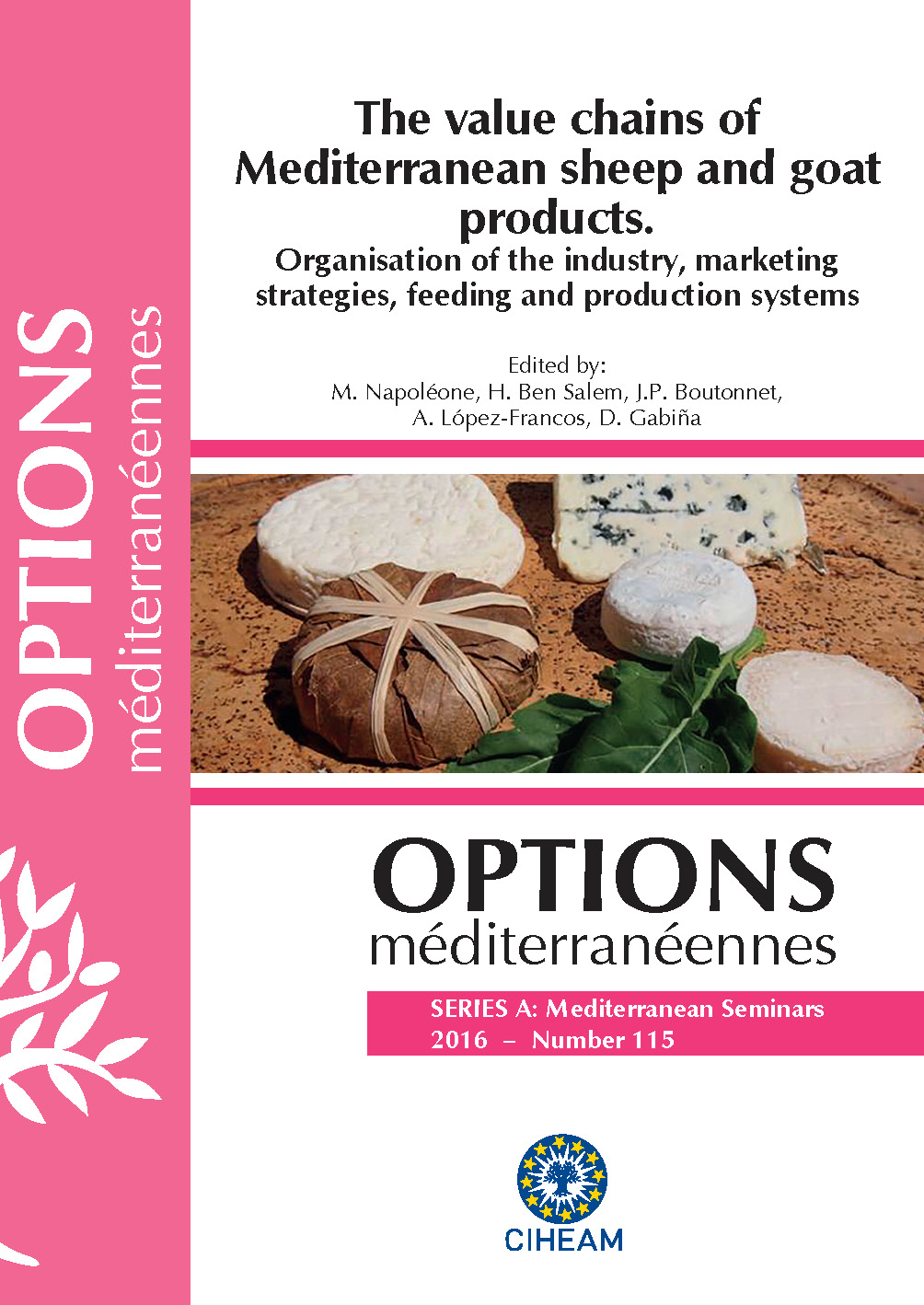| Article précédent | p. 537-541 | Article suivant |
Effect of the local forage resource, the “khortane” grass hay, on fatty acid of milk and meat of indigenous goats of southern Tunisia
The objective of this study was to determine the effect of the local feed resources on fatty acid profile of milk and meat of indigenous goat. 20 goats and 18 kids were divided in two groups each and received ad libitum oat hay diet (control diet: C) or mixed grass hay called “khortane” (diet K) in southern Tunisia. All groups received the same commercial concentrate. In the first experiment, milk from C diet goats was poorer in lauric (C12:0; 4.7% of total fatty acids methyl esters) and myristic (C14:0; 10.0%) acids than milk from K group (P < 0.05). The “khortane” considerably increased the total conjugated linoleic acid content in milk (0.75 vs. 0.64% FAME; P < 0.05). While the series n-3 fatty acids in milk were similar between the two diets. In addition, the n-6/n-3 ratio was more favorable in the C diet than in the K diets. In the second experiment, the content of saturated fatty acids (SFA) in meat was similar in the two diets. The mono-unsaturated fatty acids (MUFA) were significantly higher (P <0.05) in meat of K diet fed (47.4 vs 46.3% FAME). The polyunsaturated fatty acid level (PUFA) was not affected by the dietary treatment. Omega 3 was similar in two groups. The n6/n3 ratio is significantly affected by the diet; it was lowest in the meat of K group (3.3 vs 4.3). It is concluded that the milk and the meat produced by feeding animal “khortane”show a better nutritional quality, with a higher level of poly-unsaturated fatty acid.
L’objectif de cette étude était de déterminer l’effet des ressources alimentaires locales sur le profil des acides gras du lait et de la viande des caprins de la population locale. 20 chèvres (lait) et 18 chevreaux (viande) ont été divisés en deux groupes et ont reçu chacun ad libitum le foin d’avoine (groupe contrôle C) et un mixte de foin d’herbe localement appelé : « khortane » (groupe K). Tous les groupes ont reçu le concentré commercial. Dans la première expérience, le lait de groupe contrôle a été pauvre en acide laurique (C12 :0 ; 4,7%) et en acide myristique (C14:0; 10,0% totale des acides gras) que le lait de groupe K. Le lait du groupe K présente une teneur légèrement plus élevée (P>0,05) en acide linoléique conjugué (0,75 vs 0,64%). Les acides gras de la série n-3 sont similaires dans le lait des deux groupes. En outre, le rapport n-6 / n-3 a été plus favorable dans le lait de groupes C que le lait de groupe K. Dans la deuxième expérience, la teneur en acides gras saturés a été comparable dans la viande de deux groupes. Les acides gras mono-insaturés a été significativement plus élevés (P<0,05) dans la viande de groupe K (47,3 vs 46,3%). L’Omega 3 a été similaire dans les deux groupes. Le régime alimentaire a affecté (P <0,05) le rapport n6 / n3 (3,1 et 4,3 respectivement pour les groupes Ko et C). Il est conclu que le lait et la viande produite a partir de « khortane » ont montré une amélioration de la qualité nutritionnelle, avec un niveau plus élevé de l’acide gras polyinsaturé.
- [ Afficher ]
- [ Télécharger ]
- [ Exporter la citation ]
Vous pouvez télécharger la citation au format :
- [ Imprimer ]
-
Mots-clés
COMPOSITION CHIMIQUE, LAIT, VIANDE, ZONE ARIDECiter cet article
Ayeb N., Addis M., Fiori M., Chniter M., Khorchani T. Effect of the local forage resource, the “khortane” grass hay, on fatty acid of milk and meat of indigenous goats of southern Tunisia. In : Napoléone M. (ed.), Ben Salem H. (ed.), Boutonnet J.P. (ed.), López-Francos A. (ed.), Gabiña D. (ed.). The value chains of Mediterranean sheep and goat products. Organisation of the industry, marketing strategies, feeding and production systems. Zaragoza : CIHEAM, 2016. p. 537-541. (Options Méditerranéennes : Série A. Séminaires Méditerranéens; n. 115). Joint Seminar of the Subnetworks on Nutrition and on Production Systems of the FAO-CIHEAM Network for Research and Development in Sheep and Goats, 2015/06/16-18, Montpellier (France) . http://om.ciheam.org/om/pdf/a115/00007328.pdf



